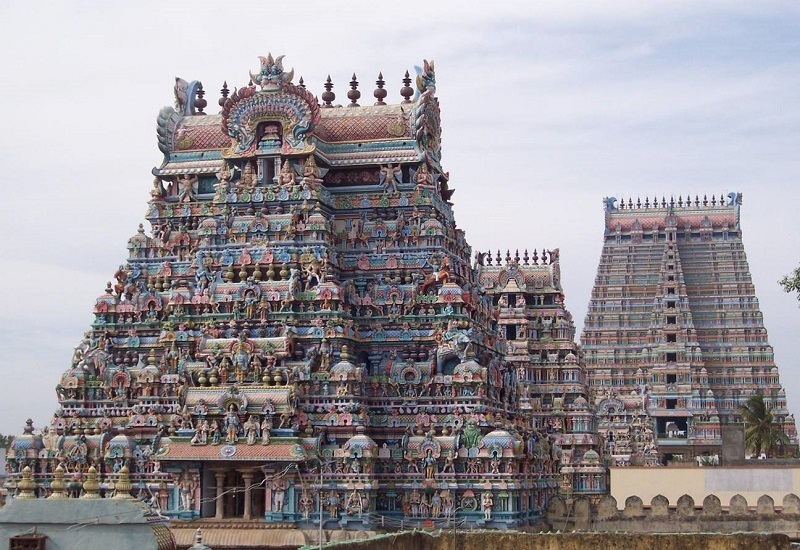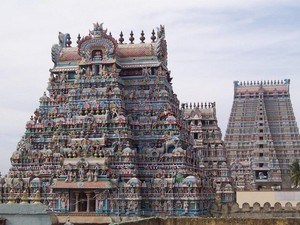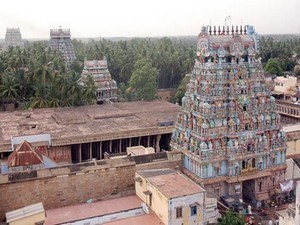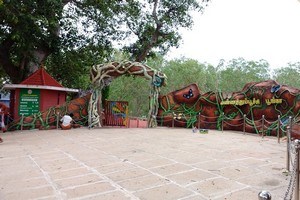Sri Ranganathaswamy Temple - Srirangam, Srirangam - Timings, History, Architecture, Best Time to Visit
Photo Credit: Flickr
 #1 of 6 Places to Visit in Srirangam
#1 of 6 Places to Visit in Srirangam
 Distance (From Srirangam): 1 Kms
Distance (From Srirangam): 1 Kms
 Trip Duration (Including Travel): 2-3 Hours
Trip Duration (Including Travel): 2-3 Hours
 Transportation Options: Bus / Cab / Auto
Transportation Options: Bus / Cab / Auto
 Travel Tips: Non-Hindus are not allowed to enter the gold topped sanctum sanctorum and their entry is restricted to the second enclosure.
Travel Tips: Non-Hindus are not allowed to enter the gold topped sanctum sanctorum and their entry is restricted to the second enclosure.
About Sri Ranganathaswamy Temple
At a distance of 1 Km from Srirangam Railway Station, and 9 Km from Trichy Railway Junction, Sri Ranganathaswamy Temple is a prominent Hindu temple situated at Srirangam, an island formed by the twin Rivers Cauvery and Kollidam. It is one of the famous temples in South India, and among the most visited pilgrimage places in Tamilnadu. This temple is dedicated to Ranganatha, a reclining form of Lord Vishnu. This temple is also known by other names such as Thiruvaranga Tirupati, Periyakoil, Bhoologa Vaikundam, and Bhogamandapam.
The temple is celebrated in the works of the Tamil poet-saints known as the Alvars, particularly in their revered text, the Naalayira Divya Prabhandam. It holds the unique honor of being the foremost among the 108 Divya Desams dedicated to Lord Vishnu. Furthermore, the Srirangam Temple is recognized as the largest religious complex in the world that is actively engaged in worship, maintaining a continuous historical presence as a Hindu temple. The temple complex has been nominated as a UNESCO World Heritage Site and is included in UNESCO's tentative list, having also received a UNESCO award for its efforts in cultural heritage conservation.
History of Sri Ranganathaswamy Temple
Among the must include places in Trichy tour packages, the Ranganathaswamy Temple in Srirangam has a long history. The Srirangam Temple was originally constructed by the Chola monarch, Dharmavarma. However, the temple's vimanam was devastated by flooding from the Kaveri River, prompting the subsequent reconstruction of the temple complex by King Killivalavan of the early Cholas, resulting in the structure that exists today. In addition to the ancient textual records, archaeological findings, including inscriptions, suggest that stone inscriptions date back to between 100 BCE and 100 CE, establishing it as one of the oldest continuously active temple complexes in South India. Numerous mandapas were erected near the main sanctum sanctorum, dating from approximately 100 CE to 300 CE, attributed to the Uraiyur Cholas. Subsequent additions and inscriptions from various dynasties, including the Chola, Pandya, Hoysala, Maratha, and Vijayanagara, reflect the temple's historical significance, with these inscriptions spanning from the 7th to the 17th centuries.
During the invasion led by Malik Kafur in 1310-1311, the deity's idol was seized and transported to Delhi. In a remarkable act of devotion, the followers of Srirangam traveled to Delhi and captivated the emperor with their performances. Impressed by their artistry, the emperor consented to return the idol. In a subsequent invasion in 1323 AD, the deity was removed before the invading forces reached Srirangam and was hidden in the hills of Tirumala Tirupati for six decades until it was restored in 1371. It is said that 13,000 devotees sacrificed their lives in a valiant effort to defend the temple. Despite facing numerous challenges and invasions, the Srirangam Temple maintained its prominence and flourished under the governance of the Vijayanagara and Nayak dynasties. In contemporary times, the Sri Ranganathaswamy Temple is overseen by the Hindu Religious and Charitable Endowments Department of the Government of Tamil Nadu.
Mythology of Sri Ranganathaswamy Temple
The Srirangam Temple is steeped in numerous mythological narratives. As recounted in the Sriranga Mahathmiyam, Brahma created the Srirangam Vimanam during the cosmic ocean's churning. This vimana was subsequently transported to Ayodhya by King Ikshvaku, a forebear of Rama. Following his victory over Ravana, Rama entrusted the idol of Ranganatha to Vibhishana, Ravana's brother. While journeying through Trichy on his way to Sri Lanka, Vibhishana placed the idol on the banks of the Kaveri River, where it remained fixed to the island. Consequently, he entrusted it to a local monarch named Dharmavarma, with the condition that the Vimanam be consecrated to eternally face the south, thereby bestowing blessings upon him and Lanka. To this day, the reclining idol of Sri Ranganatha is oriented southward, with its body aligned along the east-west axis. Additionally, the Mahabharata mentions that Arjuna visited the temple after his marriage to Ulupi.
Architecture of Sri Ranganathaswamy Temple
Sri Ranganathaswamy Temple, built in the Dravidian architectural style, stands as the most prominent of the 108 Divya Desams dedicated to Lord Vishnu. Covering an expansive area of 156 acres, this temple is the largest active Hindu temple in India and is recognized as one of the prominent pilgrimage sites in Tamil Nadu. The temple features seven enclosures surrounded by massive rampart walls that encircle the sanctum. Within the complex, there are 21 vividly adorned sculpted gopuras, 50 subsidiary shrines, and 9 sacred water bodies. The Rajagopura, soaring to a height of 236 feet, is the tallest temple tower in the country. The principal shrine, located in the innermost courtyard, enshrines the reclining 6-feet idol of Lord Ranganatha, with the vimana above the sanctum crafted from gold and safeguarded by an electric fence.
The temple complex is home to over 50 shrines dedicated to Vishnu, Lakshmi, and various Vaishnava scholars and poets. The shrines dedicated to Vishnu depict him in his numerous avatars and iconographic forms. Notable shrines within the Sri Ranganathaswamy Temple include those of Chakkaratalvar, Narasimha, Rama, Hayagriva, Vasudeva, Varadharaja, Srinivasa, and Gopala Krishna. The shrine of Ranganatha's consort, Ranganayaki, is situated in the second precinct of the temple. Additionally, there are distinct shrines honoring major saints of the Vaishnava tradition, such as Ramanuja, Nammalvar, Desikar, Thondaradipodialwar, and Thiruppaanalwar.
Numerous mandapams can be found within the Sri Ranganathaswamy Temple, with one of the most remarkable being the Hall of 1000 Pillars, constructed during the Vijayanagara period (1336-1565). Among the halls added by the Nayaks, the Sesharayar Mandapam, located on the eastern side of the fourth enclosure, is particularly noted for its artistic significance, featuring 40 intricately carved leaping animals on the piers at its northern end. The Garuda Mandapam, situated on the southern side of the third enclosure, is another Nayak addition. Within the hall, a free-standing shrine houses a prominent seated statue of Garuda. The temple has twelve major water tanks. Of these, the Surya Pushkarini (sun pool) and Chandra Pushkarani (moon pool) are two of the largest that harvest most of rainwater.
Festivals of Sri Ranganathaswamy Temple
The principal festival of the Sri Ranganathaswamy Temple is Vaikunta Ekadashi, which is celebrated with great fervor over a span of 21 days during December and January. Additionally, the temple hosts an annual chariot festival in January or February, Chithirai Car Festival in April, Vasantotsavam, Jyeshtaabhishekam, Pavitrotsavam, Teppostavam, and numerous other events, all of which are observed with significant enthusiasm at the Srirangam Temple.
Srirangam Temple Dress Code & Other Restrictions
Visitors to the Sri Ranganathaswamy Temple are expected to adhere to a conservative dress code. Men may opt for dhotis or long trousers paired with shirts, while women are encouraged to wear Sarees, Salwar Kameez, or other traditional attire that adequately covers their shoulders and legs. Shorts, mini-skirts, middies, sleeveless tops, low-waist jeans and short-length T-shirts are not allowed.
Although non-Hindus are generally permitted to visit the Ranganathaswamy Temple to admire its architectural beauty and serene atmosphere, they are usually restricted from entering the sanctum sanctorum and their entry is restricted to the second enclosure.
Srirangam Temple Timings
Monday: 6 AM - 7:15 AM, 9 AM - 12 PM, 1:15- 6 PM & 6:45 PM - 9 PM
Tuesday: 6 AM - 7:15 AM, 9 AM - 12 PM, 1:15- 6 PM & 6:45 PM - 9 PM
Wednesday: 6 AM - 7:15 AM, 9 AM - 12 PM, 1:15- 6 PM & 6:45 PM - 9 PM
Thursday: 6 AM - 7:15 AM, 9 AM - 12 PM, 1:15- 6 PM & 6:45 PM - 9 PM
Friday: 6 AM - 7:15 AM, 9 AM - 12 PM, 1:15- 6 PM & 6:45 PM - 9 PM
Saturday: 6 AM - 7:15 AM, 9 AM - 12 PM, 1:15- 6 PM & 6:45 PM - 9 PM
Sunday: 6 - 7:15 AM, 9 AM - 12 PM, 1:15- 6 PM & 6:45 - 9 PM
Sri Ranganathaswamy Temple Entry Fee
General Entry is Free
Special Darshan available for Rs. 250
Vishwaroopa Darshan for Rs. 100
Best Time to Visit Srirangam Temple
The Sri Ranganathaswamy Temple is most enjoyable to visit during the cooler months from October to March, when the weather is relatively mild, making it suitable for exploring the temple grounds and participating in religious activities. This period also coincides with a peak influx of pilgrims and tourists, as the temple hosts numerous festivals, including the renowned Vaikunta Ekadasi, which occurs in December or January. For those seeking to immerse themselves in the temple's vibrant atmosphere, it is advisable to plan a visit during significant festivals such as the Chithirai Festival in April or May and the Brahmotsavam celebrated in March or April. Although summer temperatures can be high, the festive spirit during this time provides a distinctive and exhilarating experience that outweighs the discomfort of the heat.
How to Reach Sri Ranganathaswamy Temple
Sri Ranganathaswamy Temple in Srirangam is situated 12 kilometers from Trichy that has regular flight, train and bus connectivity with all the cities, and towns in Tamil Nadu. The temple is easily accessible by road and plenty of local town buses and auto-rickshaws, cabs available from Trichy.















